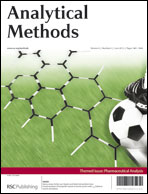A fluorescent nanofiber probe for the determination of Ni2+ was developed via the electrospinning of a covalently functionalized pyridylazo-2-naphthol-poly(acrylic acid) polymer. Fluorescent nanofibers with diameters in the range 230–800 nm were produced with uniformly dispersed fluorophores. The excitation and emission fluorescence were at wavelengths 479 and 557 nm respectively, thereby exhibiting a good Stokes' shift. This Ni2+ probe that employs fluorescence quenching in a solid receptor–fluorophore system exhibited a good correlation between the fluorescence intensity and nickel concentration up to 1.0 μg mL−1 based on the Stern–Volmer mechanism. The probe achieved a detection limit (3δ/S) of 0.07 ng mL−1 and a precision, calculated as a relative standard deviation (RSD) of <4% (n = 8). The concentration of Ni2+ in a certified reference material (SEP-3) was found to be 0.8986 μg mL−1, which is significantly comparable with the certified value of 0.8980 μg mL−1. The accuracy of the determinations, expressed as a relative error between the certified and the observed values of certified reference groundwater was ≤0.1%. The versatility of the nanofiber probe was demonstrated by affording simple, rapid and selective detection of Ni2+ in the presence of other competing metal ions by direct analysis, without employing any further sample handling steps.

You have access to this article
 Please wait while we load your content...
Something went wrong. Try again?
Please wait while we load your content...
Something went wrong. Try again?


 Please wait while we load your content...
Please wait while we load your content...